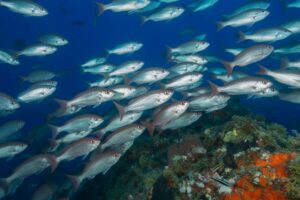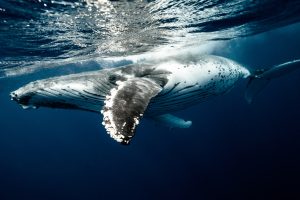Author: Nils Stolpe/FishNet USA
I’ve been reviewing my past writings to gauge which, if any, have aged gracefully and which haven’t. I’ll be redistributing those that I think were particularly noteworthy, either because they were – and perhaps still are – on target or because they weren’ t – or aren’ t. The following addresses some of the more oner- ous provisions of the Sustainable Fisheries Act of 1996, which at the time were being fully implemented. I’ll leave it up to you to determine whether I hit this nail on the head or not. I’d be really interested to hear what you think.
Feel free to reproduce or redistribute this issue of FishNet USA or any others. The only requirement is that you cite the source. It is available in Adobe Acrobat format at http://www.FishNet- USA.com/SFA_Revisit_Final.pdf. To be removed from this distribution list, please reply to this email with “remove” in the subject line.
Number 11
January 16, 2000
The Sustainable Fisheries Act, MSY and a consideration of ecological realities
It’s an accepted ecological principle that a given area of land or water under natural conditions, as long as the input of energy and other raw materials remains constant, will produce a relatively constant biomass over time. The form of that biomass – the species mix – can vary significantly, but the total amount will remain the same. Thus, without any major disturbances a square mile of woodland will produce the same amount of biomass year after year. The same can be said for a given area of wetland or estuary or coastal or offshore ocean. For example, minus any major changes in the amount of available energy (sunlight) or nutrients (from runoff and upwelling), the waters of the New York Bight will produce approximately the same tonnage of fish every year. Within that tonnage, however, the relative amounts of various species can vary tremendously.
In particular areas, many of the commercially and recreationally important fish species occupy similar or overlapping niches (a niche is most simply defined as an ecological address). That is, they are found in the same areas at the same times, they pursue the same prey, are pursued by the same predators and likely feed on each other’s young. To a large extent they can be considered in competition with each other for space, food and shelter. In some years there will be a large number of a particular species and, because of the ecological limits on the area’s ability to support total biomass, lessened numbers of the “competing” species. In the New York Bight we will have periods when bluefish are extremely plentiful and striped bass and weakfish aren’t, or, as has been the case for the last three or four years, there will be striped bass all over, a large population of fluke, and relatively few bluefish. The populations of particular fish species cycle over time in a particular area, but the total biomass at a particular trophic level remains relatively constant.
The Maximum Sustainable Yield (MSY) of a fish species or stock must necessarily be considered to be the harvest from that stock or species when its population is at or approaching its peak. Thus, the MSY for bluefish in the Mid-Atlantic is determined based on the biomass of bluefish available when the popu- lation was at its highest level. Ditto for weakfish, for striped bass, for fluke, etc. But it’s important to note that the years of peak production of these species didn’t, and in fact couldn’t, coincide. The natural pro- duction limits of the system (sunlight and nutrients) simply wouldn’t allow it.
Under the provisions of the federal Sustainable Fisheries Act (SFA), at any point when the populations of each of these competing species aren’t at MSY they are considered to be “overfished” and stringent har- vest restrictions implementing strict rebuilding schedules (to MSY) are mandated. By requiring that all species be at their MSY, our coastal waters are expected in the SFA to support a level of overall produc- tion that is ecologically impossible, and fishermen, both recreational and commercial, are expected to re- duce their catch to meet this impossible standard.
Species by species management – an idea whose time has gone?
The species-by-species management philosophy that became law with the Magnuson Act in 1976 has proved to be predictably ineffectual. This is, as far as we can tell, the reason why the New England Fish- ery Management Council voted for a dogfish harvest of over 20 million pounds while the Mid-Atlantic Council, using the same data and managing under the same guidelines, has voted to virtually close the fishery down, allowing less than 3 million pounds to be harvested. At this point dogfish are among the most abundant fish in the waters off New England and the Mid-Atlantic. They are so numerous that in the most recent survey conducted by the National Marine Fisheries Service in the waters extending from Cape Hatteras to Canada, dogfish made up over 40% by weight of all of the fish taken (See Of Dogfish and overfishing and productive capacity at http://www.fishingnj.org/netusa7.htm). The New England council members realize that if the already huge biomass of dogfish is allowed to build up to even higher levels, it will do so at the expense of “competing” and much more desirable/valuable/depleted species like cod and haddock. They have tried to act accordingly by recommending the continuation of the dogfish fishery at a reduced yet significant level of harvest. (This week the Secretary of Commerce approved the Dogfish FMP including the disturbingly low quotas, but has directed a reevaluation of the plan’s assump- tions that were used to set them.)
This isn’t just a management issue. As the provisions of the Sustainable Fisheries Act come into play over the next year, and as other fisheries are determined to be below MSY, along with the financial devastation of many fishing businesses we will be faced with the loss of critical industry infrastructure that, consider- ing development demands in coastal areas, will never be replaced. And all because we won’t be able to meet the biologically impossible goal of having numerous species at their MSY level simultaneously.
Exacerbating this situation are several other factors that might well have led to unnaturally high levels of production for particular species in the past, consequently generating even more inflated expectations of MSY .
Culminating in the 1970s or early 1980s, we had significantly “enriched” our inshore and coastal waters with untreated (or lightly treated) municipal and industrial wastewater. While some of these effluents were toxic, many were composed primarily of nutrients which might very possibly have increased the ability of the receiving waters to produce fish and shellfish. And until fairly recently we had significantly reduced the populations of cetaceans (whales, dolphins, etc.) and pinnipeds (seals and sea lions) in all of the world’s oceans. These animals are very efficient predators of many of the same fish species that we harvest, or of the species that those species prey upon.
Since then we have spent billions of dollars to reduce the amount of point-source pollutants – including uncounted tons of nutrients – entering our estuarine and coastal waters, very possibly decreasing overall biomass production in these waters (see Managing The Waterways — Too Clean For The Fish? by Alan Mearns, Lincoln Loehr and Herbet Curl. The Seattle Times. July 19, 1998). Interestingly, it’s now thought that a recent upswing in biological production in the Mediterranean is most probably due to “fer- tilization” attributable to coastal development there. At the same time, marine mammal predation on fish and shellfish has increased dramatically as their populations have increased because of the mandates of the Marine Mammal Protection Act in the U.S. and similar legislation and regulations in other countries.
We’ve also seen the unintended and uncontrolled spread of toxic materials (herbicides, pesticides, petro- leum products, etc.) in every oceanic or estuarine area that has been sampled. Finally, we’ve lost – and continue to lose – significant amounts of our coastal wetlands to development, and with them we’ve lost a corresponding amount of what is vital spawning and nursery habitat for 70% of our economically im- portant fish species. The expectation is that if we manage our fisheries correctly (meaning if we restrict harvesting rigorously enough) we can return them to levels of abundance that were commonplace several decades back. The reality is that, regardless of how stringently we control harvesting, those levels are no longer reachable.
A simple fix
It appears as if, with good intentions, the Congress of the United States has painted recreational and commercial fishermen into an ecological corner. Individual fish stocks are required by federal legislation to be returned to probably unreachable levels of former abundance (given yesterday’s sparsely developed coastlines, nutrient-rich effluents and paucity of marine mammals, and today’s abundance of marine mammals, cleaner waters and the ongoing exodus from inland areas to the coasts), and they are all re- quired to be at those levels simultaneously. That’s far beyond the productive capacities of the involved ecosystems, but in spite of that, when it doesn’t happen more stringent management measures will be im- posed on the commercial and recreational fishing industries. And this will all be going on while many fisheries are satisfactorily rebuilding towards or are already at high levels of abundance.
The immediate problem, that of drastically reducing fishing effort when impossible-to-achieve population levels aren’t reached, could be easily solved by requiring that we manage stocks of fish in naturally occur- ring assemblages rather than on a species-by-species basis. Instead of futilely attempting to simultaneous- ly return all managed fish species to peak levels of abundance, we should recognize that natural ecosys- tems have limitations and we should give our managers the flexibility to work within the constraints im- posed by those limitations. We can’t have an ocean that is filled with maximum amounts of dogfish, cod and haddock, or fluke, bluefish and weakfish all at the same time. We should recognize this and start to manage for a balance of species, with the balance determined by economic and social factors as well as the “natural order.” Logic would dictate that, considering their recreational and commercial demand, New England’s codfish are much too valuable to allow their rebuilding to be retarded in order to have an ocean even more fully populated by dogfish. But that’s what we’re being forced to do today, and our coastal communities will pay tens of millions of dollars if we don’t fix it.




